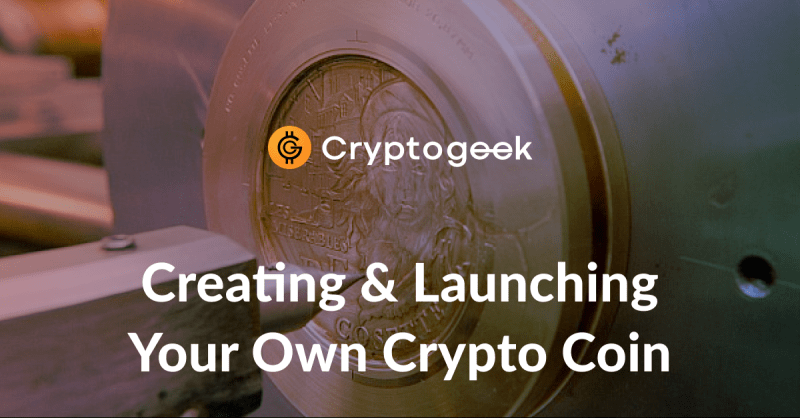How to Create and Launch Your Own Cryptocurrency: a Step-by-Step Guide


Despite Bitcoin having been created over 12 years ago, the world of cryptocurrencies and blockchain technology is still a young, unexplored one. The 2017 Bitcoin boom has definitely increased the public opinion's awareness of the advantages of decentralized currencies, with many people starting to look for ways in which they, too, could get in on the craze. Many have become crypto investors. Others, however, took a slightly different approach.
The rise of altcoins (a term used to describe cryptocurrencies that aren't Bitcoin) that followed the initial boom has made a lot of people really rich. Nowadays, coins like Ethereum or Litecoin are starting to look more like feasible investment opportunities, rather than Bitcoin copycats they were considered to be just a few years ago. Now, trying your luck with Bitcoin slots is not the only way to get rich quick with crypto. The best part? With the right equipment and determination, you, too, can launch your own altcoin and potentially see it increase in value. In this article, we will take you through the steps required to create your own cryptocurrency.
- Getting Started
- Choosing a Consensus Method
- Finalizing Your Coin Name
- Preparing a White Paper
- Source Code And Testing Phase
- Announcement of Launch
- Public Listing and Initial Distribution
- Choosing the Exchange Platform
- Meet the Requirements
- Is It Legal?
- The Bottom Line
Getting Started
To help kickstart your creative juices and give you a taste of what creating your own cryptocurrency entails, we have put together a list of topics below that should make up part of your research once the time for actual implementation comes.
The concept is one of the first things that will determine the following development of the coin is its main concept. How is it different from the existing coins? What improvements does it bring? Who will use it?
Choosing a Consensus Method
During the years of the development of the cryptocurrency industry, many different consensus mechanisms were created. They differ a lot and the consensus mechanism choice is important and determines the way the currency will function. Some developers prefer to create their own types of consensus mechanisms. One of the vivid examples of a "custom" consensus protocols is the one used by Stellar. The first consensus mechanism applied to cryptocurrencies was Proof-of-Work. It is used in the Bitcoin network. Validation of transactions requires some "work" from the computer. This work is executed while "mining" — providing calculations that prove that the node isn't a spammer or violator.
The second famous consensus mechanism is called "Proof-of-Stake". Instead of mining, users should freeze some of their funds in order to perform and validate the transaction. Many people find this mechanism more convenient while mining is criticized a lot. However, there are many things to consider, so there is no best option. There are only ones that fit your project better. Read more about consensus mechanisms here.
Finalizing Your Coin Name
Once created, a new coin must be given an initial name before listing it publicly; guidance here comes from coining names from existing monikers already available e.g., dogecoin after doge meme became popular in 2013.
No highs, no lows, only Doge
— Elon Musk (@elonmusk) February 4, 2021
Another option is simply naming it after a feature it has — e.g. BAT means Basic Attention Token because these tokens are collected in exchange for watching ads (tokenizing your attention).
Preparing A White Paper
A well-written white paper is necessary both for attracting those who will use a currency, investors, and developers eager to work with a new product to improve it or implement it on side platforms.
The Ethereum white paper was a sensation quickly making Ether and the platform behind it big news in the industry. The team that flocked around the Ethereum white paper managed to bring this coin to a second position by the market cap. The white paper should contain all the necessary tech details of the future project and explain how the product will be used by different individuals and institutions, and how they will benefit from it.
Source Code And Testing Phase
Outlining the overall technical aspects behind how your coin will work can help at this stage because it forces you to think through all aspects involved with its creation — e.g., how validation works; how to secure the network from double spending, thefts, and other threats. This also requires a server setup so that wallet testing can begin.
Announcement Of Launch
Next, you'll have to register your coin in exchanges of your choice (like, Binance). After registration has been completed successfully — it's time now for announcing publicly both locally and internationally through various social media channels. Social media platforms can help spread the word even further via influential people endorsing cryptocurrency launches on such mediums.
Public Listing And Initial Distribution
Finally comes the listing for your coin on the selected exchange platforms; this is the part where you can finally begin trading your coins/tokens! But bear in mind that any worthwhile cryptocurrency will generate hype for itself through means of marketing. It's important to get the buzz going around your coin even before launch by partnering with influential figures in the crypto industry or by getting yourself listed on websites dedicated solely to cryptocurrency startups. Another important step is the ICO campaign. The coins sold in ICO will provide money to cover some expenses and move on developing the network further.
Choosing The Exchange Platform
Different exchanges operate their systems using different platforms with varying costs associated with using them per transaction; those looking into creating their own altcoin should thus find out which platforms have lower transaction costs and zero transaction fees when the time for listing your currency on an exchange comes. High liquidity, wide functionality, and ease of use attract millions of users to such exchanges as HitBTC, Binance, Coinbase, Kraken, etc.
Meet the Requirements
Note that the decentralization and anonymity offered by cryptocurrencies open them up to potential abuse. Because of this, governments around the world are starting to pay more attention to crypto than ever before. Some have decided to forbid their use altogether (China and South Korea being a prime example), while other regulators are simply stepping up their efforts to crack down on any illegal activity related to cryptocurrencies and cryptocurrency exchanges.
So... Is It Legal?
Creating a new cryptocurrency is completely legal across countries, apart from a few exceptions (such as Ecuador, Bolivia, Bangladesh, and Kyrgyzstan). Cryptocurrencies, just like any other financial vehicle, are under very strict regulations that must be adhered to by anyone who wants to launch his or her own coin or start an exchange platform. You should stay proactive about regulation changes.
Just out! Groundbreaking innovators, political leaders, crypto influencers and advocates can be found in spots 60-51.
— Cointelegraph (@Cointelegraph) February 5, 2021
Don’t miss the #CTTop100! https://t.co/mJEmyMsWOq
You could always keep track of this information through news sites dedicated solely to cryptocurrencies or blockchain technology or by following people whose job it is to know everything about these things — CoinTelegraph is a good site to get you started.
The Bottom Line
Cryptocurrency investment comes with substantial risks besides the obvious ones most people are aware of — namely government crackdown, hacking, and theft. The biggest risk most aren't aware of, however, is losing money due to ignorance or lack of attention to small yet very important details when it comes time for actual implementation and use-cases.
That's why we strongly advise everyone who wants to invest in cryptocurrencies to have a backup plan when investing — a plan that covers such unknown eventualities as the hacking of your network and code vulnerabilities, just to name a few. If you don't want to lose everything you have invested so far, then you should find an alternative refuge for those funds not currently invested in cryptocurrencies!

शीर्ष ट्यूटोरियल
-
Что такое хард-форк?Jul 27, 2020
-
Стейкинг на Ethereum 2.0 и его основные особенностиAug 01, 2020
-
Инновации на основе блокчейна в сфере энергетикиAug 03, 2020









I was suggested this web site by my cousin. I am not sure whether this post is written by him as no one else know such detailed about my trouble.
You're incredible! Thanks! https://www.linkedin.com/pulse/t%C6%B0-v%E1%BA%A5n-x%C3%A2y-nh%C3%A0-tr%E1%BB%8Dn-g%C3%B3i-t%E1%BA%A1i-%C4%91%C4%83k-l%C4%83k-t%E1%BB%AB-thi%E1%BA%BFt-k%E1%BA%BF-%C4%91%E1%BA%BFn-thi-kim-ngan-alfnf/
Got a white paper from a new crypto currency through a friend. I am very new to crypto currency, my background is accounting, I can’t judge a white paper.
Any advice?
Greetings
Chris